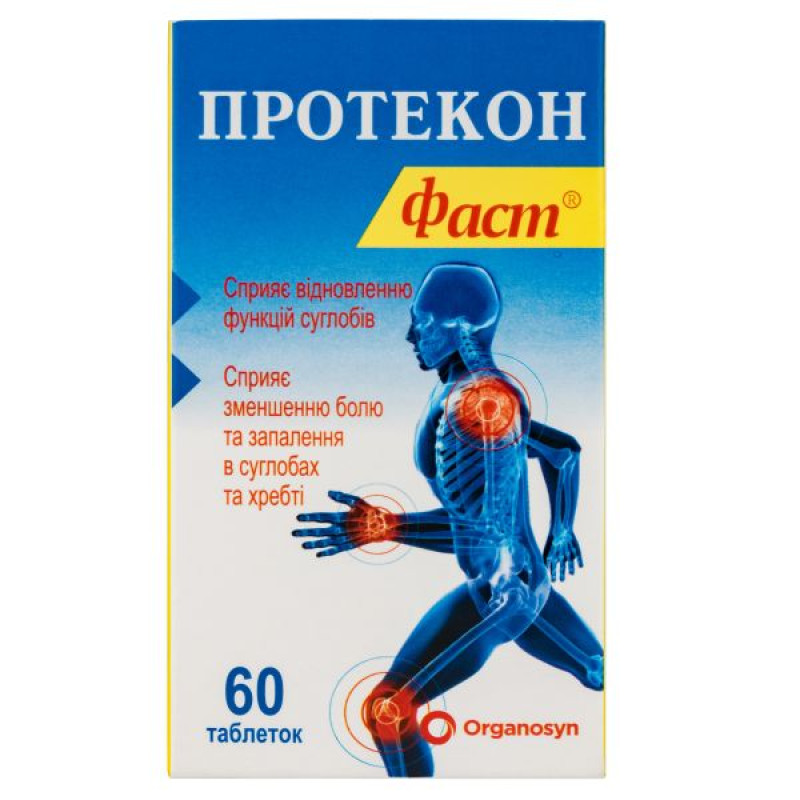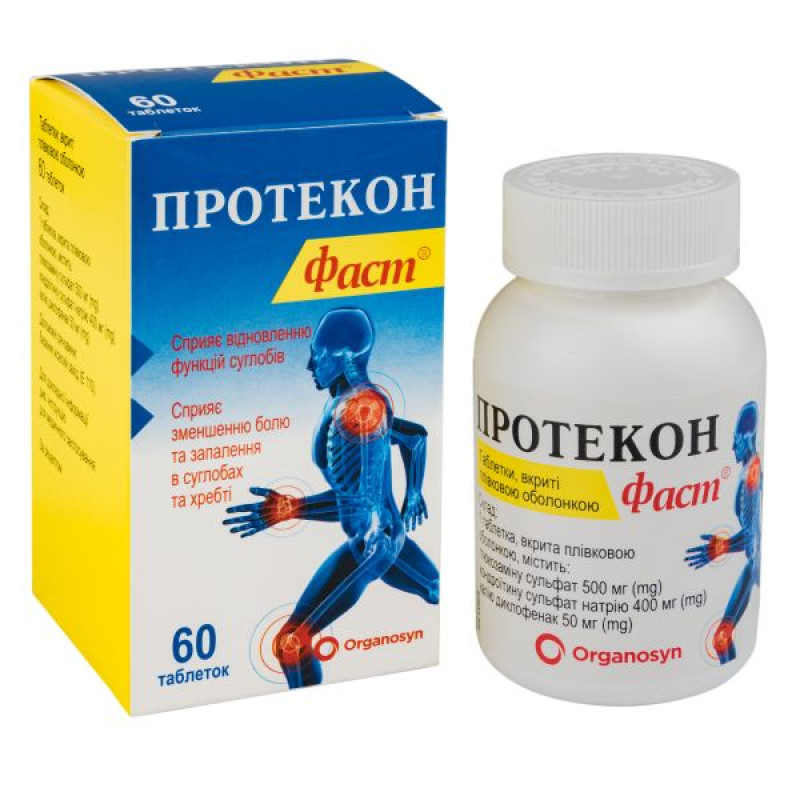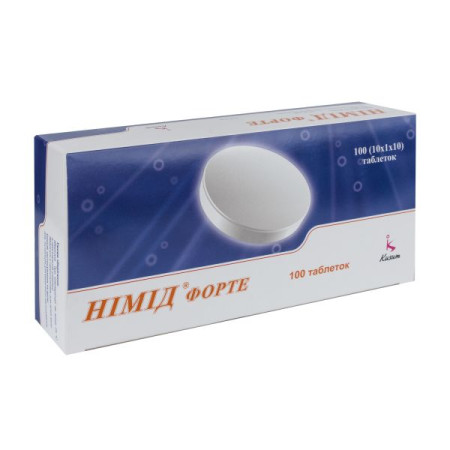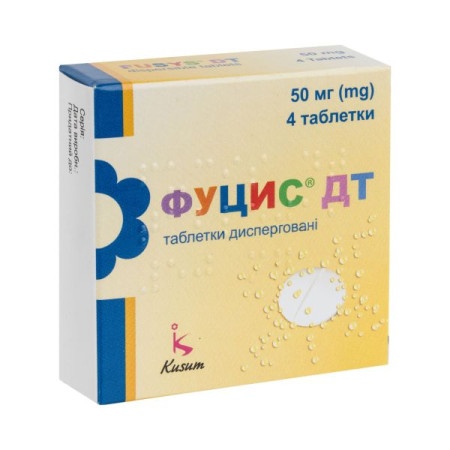Protecon Fast film-coated tablets blister No. 60
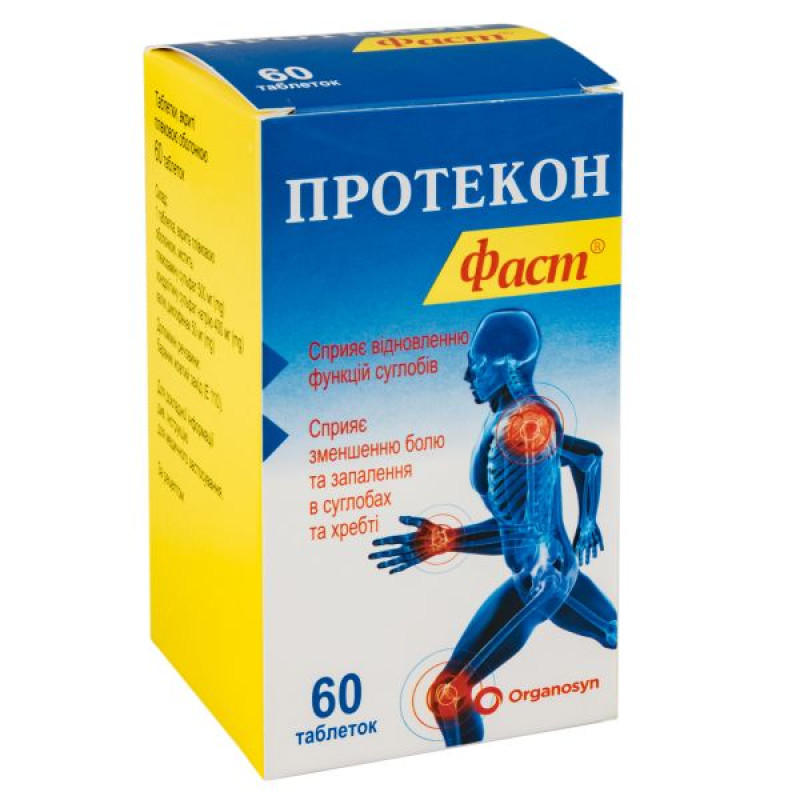
Instructions for use Protecon Fast film-coated tablets, blister pack No. 60
Composition
active ingredients: glucosamine, chondroitin sulfate, diclofenac;
1 film-coated tablet contains: glucosamine sulfate 500 mg, chondroitin sulfate sodium 400 mg, diclofenac potassium 50 mg;
Excipients: microcrystalline cellulose, magnesium stearate, povidone (K-30), sodium starch glycolate, colloidal anhydrous silica, talc, croscarmellose sodium, hypromellose, polyethylene glycol (PEG-6000), titanium dioxide (E171), sunset yellow dye (E 110), isopropyl alcohol.
Dosage form
Film-coated tablets.
Main physicochemical properties: film-coated tablets, orange in color, oval in shape, biconvex, with a score on one side.
Pharmacotherapeutic group
Drugs affecting the musculoskeletal system. Combined anti-inflammatory and antirheumatic drugs. ATX code M01B X.
Pharmacological properties
The drug has anti-inflammatory, analgesic, chondroprotective and regenerative effects.
Slows down the processes of cartilage damage and bone resorption, restores cartilage, accelerates the formation of bone callus in injuries, and helps restore joint function.
Pharmacodynamics
Glucosamine is a substrate for the construction of articular cartilage and stimulates the regeneration of cartilage tissue. Any adverse effect (disease, age-related metabolic disorders, trauma) reduces its synthesis and concentration in the connective tissue, which leads to a violation of the structure, function of the joints and the appearance of pain. Glucosaminoglycans and proteoglycans are part of the complex matrix that makes up cartilage.
Glucosamine is a component of endogenous glycosaminoglycans of cartilage tissue, stimulates the production of proteoglycans and increases the absorption of sulfate by articular cartilage.
Thus, glucosamine replenishes the endogenous deficiency of glucosamine, participates in the biosynthesis of proteoglycans and hyaluronic acid, thereby counteracting the progression of degenerative processes in the joints, spine and surrounding soft tissues; stimulates the formation of chondroitin sulfate, normalizes calcium deposition in bone tissue, promotes the restoration of joint functions and the disappearance of pain syndrome.
Chondroitin sulfate is a high-molecular mucopolysaccharide, affects the phosphorus-calcium metabolism in cartilage tissue, slows down bone resorption and reduces calcium loss, slows down the processes of cartilage degeneration. It has a chondroprotective effect, stimulates cartilage regeneration, has anti-inflammatory, analgesic effects, provides chondroprotection under normal conditions and in conditions of cartilage destruction. It prevents the compression of connective tissue, "lubricates" joint surfaces and normalizes the production of joint fluid.
Diclofenac potassium is a nonsteroidal anti-inflammatory drug (NSAID) with analgesic, anti-inflammatory and antipyretic activity, has a rapid onset of action, which is particularly suitable for the treatment of acute pain in inflammatory conditions. The mechanism of action is based on the inhibition of prostaglandin synthesis, which play a major role in the development of inflammation, pain and fever. The anti-inflammatory, analgesic and antipyretic properties of nonsteroidal anti-inflammatory drugs are associated with their ability to inhibit prostaglandin synthesis by blocking the synthesis of the enzyme cyclooxygenase. Reduces pain at rest and during movement, reduces morning stiffness in the joints, swelling of soft tissues, improves the functional state of the musculoskeletal system. Diclofenac potassium inhibits mainly the exudation phase, to a lesser extent proliferation, reducing collagen synthesis and the associated tissue sclerosis.
Pharmacokinetics
Glucosamine sulfate. The bioavailability of glucosamine when administered orally is 25-26%. After distribution in tissues, the highest concentrations are determined in the liver, kidneys and cartilage. Approximately 90% of glucosamine, which entered the body orally, is absorbed from the small intestine in the form of glucosamine salt and from there through the portal circulation enters the liver. A significant part of the absorbed glucosamine is metabolized in the liver, disintegrating into urea, water and carbon dioxide. About 30% of the dose taken persists in the connective tissue for a long time. It is excreted mainly by the kidneys and in a very small amount - with feces.
Chondroitin sulfate. After a single dose of chondroitin, the maximum concentration in blood plasma (Cmax) is reached after 3-4 hours, in synovial fluid - after 4-5 hours. The concentration in synovial fluid exceeds the concentration in plasma. The bioavailability of chondroitin sulfate is 13-15%. It is excreted by the kidneys within 24 hours.
Diclofenac potassium does not accumulate. The maximum concentration in the blood plasma is achieved through
2 hours after administration. Plasma protein binding – 99.7%. Penetrates into synovial fluid. Systemic clearance of the active substance – 263 ml/min. Plasma half-life – 1-2 hours. 60% is excreted by the kidneys in the form of metabolites, less than 1% – by the kidneys in unchanged form, the rest – in the form of metabolites with bile.
Indication
– Osteoarthritis (including knee, hip joints, intervertebral osteochondrosis, spondyloarthrosis).
Contraindication
Hypersensitivity reactions to the active substances or to other components of the drug; hypersensitivity reactions (rhinitis, urticaria, bronchospasm, angioedema) in history associated with the use of acetylsalicylic acid or other non-steroidal anti-inflammatory drugs; hypersensitivity reactions to molluscum; increased glucose tolerance, active gastric or intestinal ulcer, gastrointestinal bleeding or perforation; history of bleeding or perforation of the digestive tract associated with previous treatment with non-steroidal anti-inflammatory drugs; active peptic ulcer/bleeding or recurrent peptic ulcer/bleeding in history (2 or more separate episodes of diagnosed ulcer or bleeding); inflammatory bowel diseases (e.g. Crohn's disease or ulcerative colitis); severe hepatic insufficiency (Child-Pugh class C, cirrhosis, ascites); severe renal failure (creatinine clearance < 30 ml/min); severe heart failure (NYHA III-IV); ischemic heart disease, angina pectoris, myocardial infarction
myocardial infarction in history; treatment of postoperative pain after coronary artery bypass grafting (or use of an artificial circulatory device); cerebrovascular diseases, peripheral arterial diseases; bleeding tendency, thrombophlebitis; phenylketonuria; diabetes mellitus. Hematopoiesis disorders. Pregnancy and breastfeeding. Children up to
18 years old.
Interaction with other medicinal products and other types of interactions
When using the drug simultaneously with other medicines, the following interactions are possible:
with selective serotonin reuptake inhibitors (SSRIs) - possible increased incidence of gastrointestinal bleeding;
with cardiac glycosides - possible worsening of heart failure, a decrease in glomerular filtration rate (GFR) and an increase in the concentration of the latter in blood plasma;
with lithium, digoxin, phenytoin - an increase in the concentration of the latter in the blood plasma is possible; monitoring of the concentration of these drugs in the blood plasma is recommended;
with antidiabetic agents - although clinical studies have not shown an effect of diclofenac on the action of antidiabetic agents, hyperglycemia and hypoglycemia have been reported, requiring dose adjustment of the latter; monitoring of plasma glucose levels is recommended;
with drugs that cause hyperkalemia (such as potassium-sparing diuretics, cyclosporine, tacrolimus, trimethoprim) - an increase in plasma potassium levels is possible; monitoring of the condition of such patients is recommended;
with anticoagulants, antithrombotic agents - possible increased risk of bleeding and inhibition of platelet aggregation (when using NSAIDs, including diclofenac, in high doses). Although clinical studies have not shown an effect of diclofenac on the action of anticoagulants, an increased risk of bleeding has been reported in patients who simultaneously use diclofenac and anticoagulants; careful monitoring of the condition of such patients is necessary;
with tacrolimus, cyclosporine - increased nephrotoxicity is possible; when used simultaneously with cyclosporine, dosage adjustment of the drug is recommended;
with diuretics, antihypertensive agents - possible reduction of the antihypertensive effect; this combination should be used with caution; blood pressure and renal function should be monitored (especially in elderly patients) after the start of combination therapy, and then regularly, especially when using diuretics and ACE inhibitors, due to the increased risk of nephrotoxicity; patients should receive an adequate amount of fluid;
with quinolone antibiotics - there have been reports of convulsions, the occurrence of which may be associated with the simultaneous use of quinolones and NSAIDs, including diclofenac.
This has been observed in patients with and without a history of epilepsy or seizures; this combination should be used with caution;
with mifepristone - a possible decrease in the effectiveness of the latter; the use of NSAIDs, including diclofenac, is recommended 8-12 days after the use of mifepristone;
with methotrexate - possible increase in the concentration and toxicity of the latter; caution should be exercised when prescribing NSAIDs, including diclofenac, for less than
24 hours before using methotrexate;
with other NSAIDs (including selective cyclooxygenase-2 inhibitors), corticosteroids - an increase in the frequency of adverse reactions from the digestive tract is possible; simultaneous use of 2 or more NSAIDs should be avoided;
with colestipol, cholestyramine - a delay or decrease in the absorption of diclofenac is possible; the use of diclofenac is recommended at least 1 hour before or 4-6 hours after the use of colestipol/cholestyramine;
with drugs that are potent CYP2C9 inhibitors - a significant increase in peak plasma concentration and enhanced effects of diclofenac due to inhibition of its metabolism is possible; this combination should be used with caution.
Application features
General.
The drug should not be used with systemic NSAIDs, such as selective cyclooxygenase-2 inhibitors, due to the lack of any evidence of a synergistic effect and due to potential additive side effects.
As with other NSAIDs, including diclofenac, allergic reactions, including anaphylactic/anaphylactoid reactions, may occur, even without prior exposure to diclofenac.
Due to its pharmacodynamic properties, diclofenac, like other NSAIDs, may mask the symptoms of infections.
Special categories of patients.
The drug should be used with caution in elderly patients. It is recommended to use the lowest effective dose in frail elderly patients or patients with low body weight.
Patients with systemic lupus erythematosus and mixed connective tissue diseases are at increased risk of developing aseptic meningitis.
Special precautions (emergency medical attention) are necessary when using the drug in patients with asthma, seasonal allergic rhinitis, swelling of the nasal mucosa (e.g. nasal polyps), chronic obstructive pulmonary disease (COPD) or chronic respiratory tract infections (especially with manifestations similar to symptoms of allergic rhinitis), since such patients, when taking NSAIDs, including diclofenac, more often than others, experience side effects such as exacerbation of asthma (so-called analgesic intolerance or analgesic asthma), angioedema or urticaria. The above also applies to patients with allergic manifestations, in particular rash, itching or urticaria, when using other drugs.
Drugs that inhibit prostaglandin synthetase activity, including diclofenac, may provoke the development of bronchospasm when used in patients with bronchial asthma, including a history of it.
The drug should be used with caution in patients receiving concomitant medications that increase the risk of ulceration or bleeding, such as systemic corticosteroids, anticoagulants (e.g. warfarin), antithrombotic agents (e.g. ASA) or selective serotonin reuptake inhibitors.
Effect on the cardiovascular system.
Cases of fluid retention and oedema have been reported with NSAIDs, including diclofenac. There is an increased risk of thrombotic cardiovascular and cerebrovascular events with the use of certain selective COX-1/COX-2 inhibitors, including some NSAIDs. Evidence suggests that the use of diclofenac, particularly at high doses (150 mg/day) and in long-term treatment, may be associated with a small increased risk of arterial thrombotic events (e.g. myocardial infarction or stroke).
The drug should be used under close medical supervision in patients with a history of arterial hypertension and/or mild to moderate congestive heart failure.
The drug should be used only after careful risk/benefit assessment in patients with uncontrolled hypertension or significant risk factors (such as hypertension, hyperlipidemia, smoking). To minimize undesirable effects, the lowest effective dose should be used for the shortest period of time sufficient to control symptoms.
Effect on hematological parameters.
The drug is recommended for short-term treatment only. If this drug is prescribed for a longer period, it is recommended (as for other NSAIDs) to regularly monitor the blood count.
Patients with impaired hemostasis, hemorrhagic diathesis or hematological disorders should be carefully monitored, as diclofenac may temporarily inhibit platelet aggregation.
Effect on the liver.
With all NSAIDs, including diclofenac, the level of one or more liver enzymes may increase. Patients with impaired renal function should be under close medical supervision, as their condition may worsen. During long-term treatment with diclofenac, regular monitoring of liver function is indicated as a precautionary measure. If the deviation from normal liver function tests persists or worsens, clinical symptoms of liver disease appear or other manifestations are observed (eosinophilia, rash), the drug should be discontinued. Hepatitis may develop while taking diclofenac without prodromal symptoms. The drug should be used with caution in patients with hepatic porphyria, as it may cause exacerbation.
Effect on the kidneys.
Fluid retention and edema have been reported with NSAIDs, including diclofenac. The drug should be used with caution in patients with impaired cardiac or renal function, a history of hypertension, the elderly, patients receiving concomitant treatment with diuretics or drugs that may significantly affect renal function, and patients with significant volume depletion from any cause, such as before or after major surgery.
When using the drug, kidney function should be monitored.
Gastrointestinal bleeding (hemorrhage, melena), ulceration or perforation, which can be fatal, have been reported with all NSAIDs, including diclofenac, and may occur at any time during treatment with or without warning symptoms or a previous history of serious gastrointestinal events. These events are usually more severe in the elderly. If gastrointestinal bleeding or ulceration occurs in patients receiving diclofenac, the drug should be discontinued.
The risk of gastrointestinal bleeding, ulceration or perforation increases with increasing dose of NSAIDs, including diclofenac, and in patients with a history of ulcer, especially with complications such as bleeding or perforation.
Elderly patients have an increased frequency of adverse reactions when using NSAIDs, especially gastrointestinal bleeding and perforation, which can be fatal.
The drug should be used with caution and under medical supervision in patients with symptoms suggestive of gastrointestinal disorders or with a history of gastric or intestinal ulcers, bleeding, or perforation.
Patients with a history of gastrointestinal toxicity, especially the elderly, should report any unusual abdominal symptoms (especially gastrointestinal bleeding).
To reduce the risk of such toxic effects on the digestive tract, treatment with the drug in patients with a history of ulcer, especially complicated by bleeding or perforation, and elderly patients should be initiated and maintained at the lowest effective dose.
Combination therapy with protective agents (e.g. proton pump inhibitors or misoprostol) should be considered in patients requiring concomitant use of low-dose acetylsalicylic acid (ASA/aspirin) or other drugs that increase the risk of gastrointestinal adverse events.
Effect on the skin.
Serious skin reactions (some of which were fatal) have been reported rarely with the use of NSAIDs, including diclofenac, including exfoliative dermatitis, Stevens-Johnson syndrome and toxic epidermal necrolysis. The highest risk of these reactions is observed at the beginning of the course of therapy: reactions appear in most cases within the first month of treatment. The drug should be discontinued at the first appearance of skin rash, mucosal lesions or any other sign of hypersensitivity.
Use during pregnancy or breastfeeding
Do not use the drug during pregnancy or breastfeeding.
As with other NSAIDs, diclofenac may impair female fertility and is therefore not recommended in women attempting to conceive. Discontinuation of the drug should be considered in women who are unable to conceive or in women undergoing investigation of infertility.
Ability to influence reaction speed when driving vehicles or other mechanisms
Usually, when taking the drug in the recommended dose and with a short course of treatment, there is no effect on the speed of reactions. However, patients who experience central nervous system dysfunction when using the drug should not drive or operate other mechanisms.
Method of administration and doses
The drug is used for adults in a dose of 1 tablet 2 times a day. The tablets are taken orally before meals, washed down with water. The total duration of treatment in the recommended dose should not exceed 10 days.
The treatment regimen is selected individually. According to the doctor's prescription, the treatment may be longer. Then continue the treatment with drugs containing glucosamine sulfate and chondroitin sulfate.
It is recommended to use the drug in the lowest effective dose for the shortest period of time.
Children.
The drug is not used in pediatric practice.
Overdose
Possible increased side effects.
Symptoms: There is no typical clinical picture of diclofenac overdose. Overdose may cause the following symptoms: headache, nausea, vomiting, epigastric pain, gastrointestinal bleeding, diarrhea, dizziness, disorientation, agitation, coma, drowsiness, tinnitus, fainting or convulsions. In case of severe poisoning, acute renal failure and liver damage may develop.
Treatment: supportive and symptomatic therapy for complications such as hypotension, renal failure, convulsions, gastrointestinal disorders, respiratory depression. Special measures such as forced diuresis, dialysis or hemoperfusion do not contribute to the accelerated elimination of the drug from the body due to the high degree of protein binding and extensive metabolism of diclofenac. In case of potentially toxic overdose, it is necessary to evacuate the stomach contents (induce vomiting, wash the stomach) and use activated charcoal.
Adverse reactions
Immune system disorders: hypersensitivity reactions, including pruritus, rash (including erythematous, bullous), urticaria, eczema, erythema multiforme (including Stevens-Johnson syndrome), toxic epidermal necrolysis, erythroderma (exfoliative dermatitis), anaphylactic and anaphylactoid reactions (including hypotension and shock), angioedema, bronchial asthma (including dyspnea), pneumonitis, vasculitis.
On the part of the digestive tract: abdominal pain, nausea, vomiting, diarrhea, feeling of cramps, dyspepsia, bloating, anorexia, stomatitis, aphthous stomatitis, glossitis, changes in the esophagus, gastritis, stomach and intestinal ulcers, including with bleeding or perforation (sometimes fatal, especially in elderly patients), gastrointestinal bleeding (hemorrhagic vomiting, melena, diarrhea with blood), the occurrence of diaphragmatic strictures in the intestine, disorders of the lower intestinal tract, such as colitis, nonspecific hemorrhagic colitis, exacerbation of nonspecific ulcerative colitis or Crohn's disease, constipation, pancreatitis.
Hepatobiliary system: liver dysfunction, increased serum aminotransferase levels, hepatitis with or without jaundice, fulminant hepatitis, liver necrosis, hepatic failure.
Nervous system: headache, dizziness, drowsiness, insomnia, sensory disturbances, including paresthesia, memory impairment, disorientation, vertigo, irritability, fatigue, confusion, hallucinations, cerebrovascular disorders, convulsions, depression, anxiety, general weakness, night terrors, tremor, psychotic disorders, aseptic meningitis, optic neuritis.
From the sensory organs: visual impairment (blurred vision, diplopia), hearing impairment, tinnitus, taste disturbance.
Skin and subcutaneous tissue disorders: alopecia, photosensitivity, purpura, including allergic purpura, dermatitis.
From the genitourinary system: edema, acute renal failure, changes in urine sediment (hematuria, proteinuria), interstitial nephritis, nephrotic syndrome, papillary necrosis, medullary necrosis of the kidney. Tubulointerstitial nephritis, fluid retention in the body, impotence.
From the blood and lymphatic system: anemia (including hemolytic, aplastic), thrombocytopenia, leukopenia, agranulocytosis.
Cardiovascular: palpitations, chest pain, hypertension or hypotension, vasculitis, heart failure. Research data suggest an increased risk of thrombotic complications (such as myocardial infarction or stroke) associated with the use of diclofenac, particularly at high therapeutic doses (150 mg per day) and with prolonged use.
Expiration date
3 years.
Storage conditions
Store in the original packaging, out of the reach of children, at a temperature not exceeding 25 °C.
Packaging
30, 60 or 90 film-coated tablets in blisters or in a container.
Vacation category
According to the recipe.
Producer
Evertogen Life Sciences Limited.
Location of the manufacturer and its business address
Plot No. S-8, S-9, S-13 and S-14, A.P.I.C, S.I.Z Pharma, Green Industrial Park, Polepally (BI), Yedcherla (EM), Mahabubnagar, IN - 509 301, India/
Plot No. S-8, S-9, S-13 & S-14, APIIC, Pharma Sez, Green Industrial Park, Polepally (V), Jadcherla (M), Mahabubnagar, In-509 301, India.
There are no reviews for this product.
There are no reviews for this product, be the first to leave your review.
No questions about this product, be the first and ask your question.







